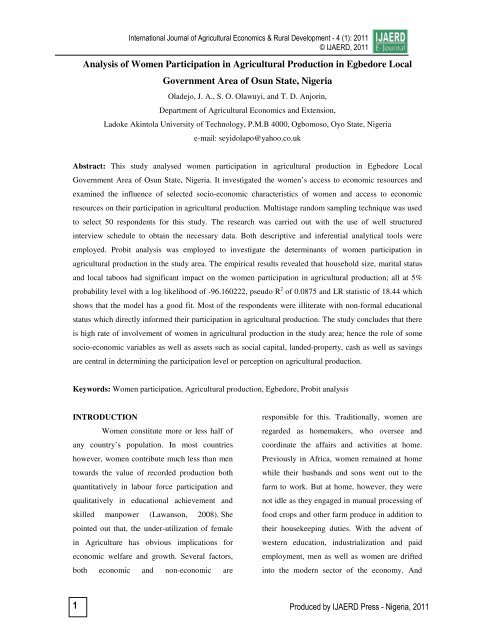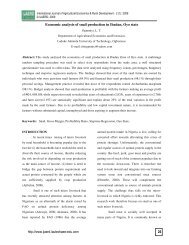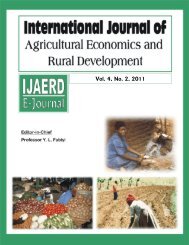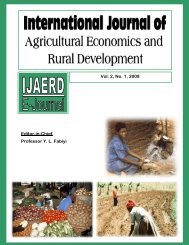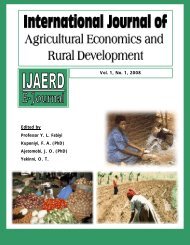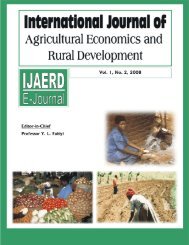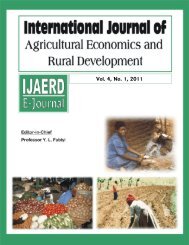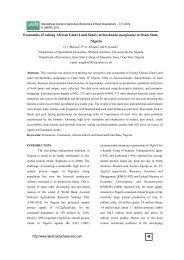1 Analysis of Women Participation in Agricultural Production in ...
1 Analysis of Women Participation in Agricultural Production in ...
1 Analysis of Women Participation in Agricultural Production in ...
You also want an ePaper? Increase the reach of your titles
YUMPU automatically turns print PDFs into web optimized ePapers that Google loves.
! " <br />
<strong>Analysis</strong> <strong>of</strong> <strong>Women</strong> <strong>Participation</strong> <strong>in</strong> <strong>Agricultural</strong> <strong>Production</strong> <strong>in</strong> Egbedore Local<br />
Government Area <strong>of</strong> Osun State, Nigeria<br />
Oladejo, J. A., S. O. Olawuyi, and T. D. Anjor<strong>in</strong>,<br />
Department <strong>of</strong> <strong>Agricultural</strong> Economics and Extension,<br />
Ladoke Ak<strong>in</strong>tola University <strong>of</strong> Technology, P.M.B 4000, Ogbomoso, Oyo State, Nigeria<br />
e-mail: seyidolapo@yahoo.co.uk<br />
Abstract: This study analysed women participation <strong>in</strong> agricultural production <strong>in</strong> Egbedore Local<br />
Government Area <strong>of</strong> Osun State, Nigeria. It <strong>in</strong>vestigated the women’s access to economic resources and<br />
exam<strong>in</strong>ed the <strong>in</strong>fluence <strong>of</strong> selected socio-economic characteristics <strong>of</strong> women and access to economic<br />
resources on their participation <strong>in</strong> agricultural production. Multistage random sampl<strong>in</strong>g technique was used<br />
to select 50 respondents for this study. The research was carried out with the use <strong>of</strong> well structured<br />
<strong>in</strong>terview schedule to obta<strong>in</strong> the necessary data. Both descriptive and <strong>in</strong>ferential analytical tools were<br />
employed. Probit analysis was employed to <strong>in</strong>vestigate the determ<strong>in</strong>ants <strong>of</strong> women participation <strong>in</strong><br />
agricultural production <strong>in</strong> the study area. The empirical results revealed that household size, marital status<br />
and local taboos had significant impact on the women participation <strong>in</strong> agricultural production; all at 5%<br />
probability level with a log likelihood <strong>of</strong> -96.160222, pseudo R 2 <strong>of</strong> 0.0875 and LR statistic <strong>of</strong> 18.44 which<br />
shows that the model has a good fit. Most <strong>of</strong> the respondents were illiterate with non-formal educational<br />
status which directly <strong>in</strong>formed their participation <strong>in</strong> agricultural production. The study concludes that there<br />
is high rate <strong>of</strong> <strong>in</strong>volvement <strong>of</strong> women <strong>in</strong> agricultural production <strong>in</strong> the study area; hence the role <strong>of</strong> some<br />
socio-economic variables as well as assets such as social capital, landed-property, cash as well as sav<strong>in</strong>gs<br />
are central <strong>in</strong> determ<strong>in</strong><strong>in</strong>g the participation level or perception on agricultural production.<br />
Keywords: <strong>Women</strong> participation, <strong>Agricultural</strong> production, Egbedore, Probit analysis<br />
INTRODUCTION<br />
<strong>Women</strong> constitute more or less half <strong>of</strong><br />
any country’s population. In most countries<br />
however, women contribute much less than men<br />
towards the value <strong>of</strong> recorded production both<br />
quantitatively <strong>in</strong> labour force participation and<br />
qualitatively <strong>in</strong> educational achievement and<br />
skilled manpower (Lawanson, 2008). She<br />
po<strong>in</strong>ted out that, the under-utilization <strong>of</strong> female<br />
<strong>in</strong> Agriculture has obvious implications for<br />
economic welfare and growth. Several factors,<br />
both economic and non-economic are<br />
responsible for this. Traditionally, women are<br />
regarded as homemakers, who oversee and<br />
coord<strong>in</strong>ate the affairs and activities at home.<br />
Previously <strong>in</strong> Africa, women rema<strong>in</strong>ed at home<br />
while their husbands and sons went out to the<br />
farm to work. But at home, however, they were<br />
not idle as they engaged <strong>in</strong> manual process<strong>in</strong>g <strong>of</strong><br />
food crops and other farm produce <strong>in</strong> addition to<br />
their housekeep<strong>in</strong>g duties. With the advent <strong>of</strong><br />
western education, <strong>in</strong>dustrialization and paid<br />
employment, men as well as women are drifted<br />
<strong>in</strong>to the modern sector <strong>of</strong> the economy. And<br />
<br />
# $ $ % & # ' "
! " <br />
today, there are visible changes <strong>in</strong> the perception<br />
<strong>of</strong> women, pr<strong>in</strong>cipally because they have greater<br />
opportunities for education than before. They<br />
now constitute themselves <strong>in</strong>to various societies<br />
or organizations and they are aggressively<br />
fight<strong>in</strong>g for the liberalization <strong>of</strong> the role <strong>of</strong><br />
women as opposed to restrict<strong>in</strong>g them to the<br />
home and home-based activities. In Nigeria<br />
today, however, women are excluded from<br />
certa<strong>in</strong> occupational categories due to formal<br />
barriers as well as <strong>in</strong>formal barriers to entry; the<br />
formal barriers which cont<strong>in</strong>ue to h<strong>in</strong>der the<br />
entry <strong>of</strong> women <strong>in</strong>to such occupational<br />
categories <strong>in</strong>clude: (i) lack <strong>of</strong> educational or<br />
technical tra<strong>in</strong><strong>in</strong>g, (ii) labour laws and trad<strong>in</strong>g<br />
customs. The <strong>in</strong>formal barriers <strong>in</strong>clude: (i)<br />
customs and religious practices, (ii) difficulties<br />
<strong>in</strong> comb<strong>in</strong><strong>in</strong>g domestic and labour market<br />
activities, (iii) management and worker attitudes,<br />
(Lawanson, 2008). Accord<strong>in</strong>g to Anne and Mary<br />
(1998), the early studies legitimized the idea <strong>of</strong><br />
women as productive partners <strong>in</strong> agriculture,<br />
discover<strong>in</strong>g and document<strong>in</strong>g the various roles<br />
played by women as farmers, farm wives, and<br />
agricultural pr<strong>of</strong>essionals and recount<strong>in</strong>g the<br />
stories <strong>of</strong> successful women <strong>in</strong> these roles.<br />
Nigerian women are saddled with most <strong>of</strong> the<br />
tasks <strong>in</strong> agricultural production 'supposedly'<br />
meant for the man but the benefits ga<strong>in</strong>ed by<br />
them are not commensurate to the man-hours<br />
they spend on the task. Despite the dom<strong>in</strong>ant and<br />
important role women play <strong>in</strong> agricultural<br />
production <strong>in</strong> the country, they are hardly given<br />
any attention <strong>in</strong> the area <strong>of</strong> tra<strong>in</strong><strong>in</strong>g and/or<br />
visitation by extension agents with improved<br />
technologies. Banks hardly grant them loans and<br />
they are hardly reached with improved seeds,<br />
fertilizer and other <strong>in</strong>puts (Damisa, Samndi and<br />
Yohanna, 2007) cit<strong>in</strong>g (Saito and Spurr<strong>in</strong>g,<br />
1992). These conditions have entrenched the<br />
women <strong>in</strong> a vicious cycle <strong>of</strong> poverty that places<br />
them at a less advantageous vantage <strong>of</strong> <strong>in</strong>come<br />
and resource empowerment. Few Nigerian<br />
women are engaged <strong>in</strong> top management cadre <strong>of</strong><br />
formal sector establishments simply because<br />
majority <strong>of</strong> them lack the educational<br />
qualifications necessary for such positions. There<br />
is a long history <strong>of</strong> women participation <strong>in</strong><br />
productive labour <strong>in</strong> Nigeria. In traditional<br />
communities, women like their male<br />
counterparts, hold farmlands and assist their<br />
husbands <strong>in</strong> all farm<strong>in</strong>g activities. Besides<br />
work<strong>in</strong>g on the farms, women <strong>of</strong> Nigeria as<br />
elsewhere <strong>in</strong> West Africa, actively participate <strong>in</strong><br />
non-agricultural activities such as craft and<br />
dye<strong>in</strong>g, weav<strong>in</strong>g and sp<strong>in</strong>n<strong>in</strong>g, food process<strong>in</strong>g,<br />
retail trade and other home-based <strong>in</strong>formal<br />
activities. Lawanson (2008) shed more light on<br />
the role <strong>of</strong> Nigerian women <strong>in</strong> agriculture. As <strong>in</strong><br />
other parts <strong>of</strong> Africa, Nigerian women have<br />
worked side by side with men <strong>in</strong> agriculture with<br />
some marked division <strong>of</strong> labour between them.<br />
The men performed the tedious tasks <strong>of</strong> fell<strong>in</strong>g<br />
trees, gather<strong>in</strong>g and burn<strong>in</strong>g <strong>of</strong> bush and mak<strong>in</strong>g<br />
ridges while women were <strong>in</strong>volved <strong>in</strong> plant<strong>in</strong>g <strong>of</strong><br />
seeds particularly food crops, harvest<strong>in</strong>g,<br />
transportation, process<strong>in</strong>g and sell<strong>in</strong>g <strong>of</strong> farm<br />
products. In Nigeria, there are significant<br />
regional differences <strong>in</strong> women participation <strong>in</strong><br />
agriculture. For <strong>in</strong>stance, a study <strong>of</strong> women <strong>in</strong><br />
the country revealed that on an overall basis, 40<br />
per cent <strong>of</strong> the rural women surveyed regarded<br />
farm<strong>in</strong>g as their major occupation. On regional<br />
basis, 89, 10 and 6 per cent <strong>of</strong> those <strong>in</strong> the East,<br />
( ))* * * +,$ + ( $ +
! " <br />
West and South respectively regarded agriculture<br />
as their ma<strong>in</strong> occupation (Lawanson, 2008).<br />
Damisa et al., (2007) po<strong>in</strong>ted out that<br />
various researches conducted on the contribution<br />
<strong>of</strong> women to agricultural development <strong>in</strong> the<br />
country suggest that women contribution to farm<br />
work is as high as between 60 and 90% <strong>of</strong> the<br />
total farm task performed. The contribution <strong>of</strong><br />
the women ranges from such tasks as land<br />
clear<strong>in</strong>g, land-till<strong>in</strong>g, plant<strong>in</strong>g, weed<strong>in</strong>g,<br />
fertilizer/manure application to harvest<strong>in</strong>g, food<br />
process<strong>in</strong>g, thresh<strong>in</strong>g, w<strong>in</strong>now<strong>in</strong>g, mill<strong>in</strong>g,<br />
transportation and market<strong>in</strong>g as well as the<br />
management <strong>of</strong> livestock. Charles and Willem<br />
(2008) op<strong>in</strong>ed that the importance <strong>of</strong> the role<br />
played by women <strong>in</strong> agricultural production is<br />
such that the widespread failure so far to reach<br />
women farmers through formal extension<br />
services has major repercussions for national<br />
output and food security as well as social justice.<br />
Sharon (2008) viewed that both women and men<br />
play critical roles <strong>in</strong> agriculture throughout the<br />
world, produc<strong>in</strong>g, process<strong>in</strong>g and provid<strong>in</strong>g the<br />
food we eat. <strong>Women</strong> make up half the rural<br />
population and they constitute more than half <strong>of</strong><br />
the agricultural labor force. Rural women <strong>in</strong><br />
particular are responsible for half <strong>of</strong> the world's<br />
food production and produce between 60 and 80<br />
percent <strong>of</strong> the food <strong>in</strong> most develop<strong>in</strong>g countries.<br />
Yet, despite their contribution to global food<br />
security, women farmers are frequently<br />
underestimated and overlooked <strong>in</strong> development<br />
strategies.<br />
Fabiyi, Danladi, Akande, and Mahmood<br />
(2007) quot<strong>in</strong>g Folasade (1991) on ‘the role <strong>of</strong><br />
women <strong>in</strong> food production’ submitted that lack<br />
<strong>of</strong> separate land for women and <strong>in</strong>adequate<br />
contact with extension agents are serious<br />
constra<strong>in</strong>ts faced by women farmers. <strong>Women</strong><br />
very rarely own land <strong>in</strong> Nigeria, despite their<br />
heavy <strong>in</strong>volvement <strong>in</strong> agriculture. Because<br />
women generally do not own land or other assets<br />
it has traditionally been difficult for women to<br />
obta<strong>in</strong> Bank loans or other forms <strong>of</strong> credit<br />
through the bank<strong>in</strong>g system. Land tenure system<br />
is largely by <strong>in</strong>heritance. This lack <strong>of</strong> title to land<br />
prevents women from exercis<strong>in</strong>g or improv<strong>in</strong>g<br />
their expertise <strong>in</strong> crop production and animal<br />
husbandry because <strong>of</strong> security <strong>of</strong> tenure.<br />
Majority <strong>of</strong> them use low yield<strong>in</strong>g and<br />
unimproved plant<strong>in</strong>g materials, primitive and<br />
labour <strong>in</strong>tensive farm implements, traditional<br />
farm<strong>in</strong>g practices, which have adversely affected<br />
agricultural production. It has been reported that<br />
80% <strong>of</strong> the work done on the farm <strong>in</strong> agricultural<br />
activities takes place <strong>in</strong> rural areas. It is now<br />
widely demonstrated that rural women, as well<br />
as men, throughout the world are engaged <strong>in</strong> a<br />
range <strong>of</strong> productive activities essential to<br />
household welfare, agricultural productivity and<br />
economic growth. Yet women’s substantial<br />
contribution cont<strong>in</strong>ues to be under-valued <strong>in</strong><br />
conventional agricultural and economic analyses<br />
and policies, while men’s contribution rema<strong>in</strong>s<br />
the central, <strong>of</strong>ten sole focus <strong>of</strong> attention (Fabiyi<br />
et al., 2007).<br />
Objectives <strong>of</strong> the Study<br />
The ma<strong>in</strong> objective <strong>of</strong> this study is to<br />
analyze women participation <strong>in</strong> <strong>Agricultural</strong><br />
production <strong>in</strong> Egbedore L.G.A. <strong>of</strong> Osun State.<br />
The specific objectives are to:<br />
1. identify the personal and socioeconomic<br />
characteristics <strong>of</strong> the<br />
respondents.<br />
<br />
# $ $ % & # ' "
! " <br />
2. determ<strong>in</strong>e the women’s access to<br />
economic resources (<strong>in</strong>clud<strong>in</strong>g access to<br />
capital, land, natural resources, credit<br />
and sav<strong>in</strong>gs programmes), technical and<br />
pr<strong>of</strong>essional skills <strong>in</strong>formation.<br />
3. exam<strong>in</strong>e the <strong>in</strong>fluence <strong>of</strong> selected socioeconomic<br />
characteristics <strong>of</strong> women and<br />
access to economic resources on their<br />
participation <strong>in</strong> agricultural production.<br />
4. identify the constra<strong>in</strong>ts militat<strong>in</strong>g<br />
aga<strong>in</strong>st women participation <strong>in</strong><br />
agricultural production.<br />
Hypothesis <strong>of</strong> the study<br />
Null hypothesis (H o ): There is no<br />
significant relationship between selected socioeconomic<br />
characteristics <strong>of</strong> women, access to<br />
economic resources and the level <strong>of</strong> their<br />
participation <strong>in</strong> agricultural production.<br />
LITERATURE REVIEW<br />
Damisa and Yohanna (2007) stated that<br />
the role <strong>of</strong> women <strong>in</strong> agricultural production <strong>in</strong><br />
Nigeria can never be underestimated. They<br />
perform crucial roles <strong>in</strong> the domestic and<br />
economic life <strong>of</strong> the society. Rural and national<br />
developments can hardly be achieved with the<br />
neglect <strong>of</strong> this important and substantial segment<br />
<strong>of</strong> the society. In recognition <strong>of</strong> the important<br />
role <strong>of</strong> women <strong>in</strong> nation build<strong>in</strong>g, the Nigerian<br />
Government more than ever before is keen upon<br />
rural poverty alleviation as a way <strong>of</strong> improv<strong>in</strong>g<br />
the economy. As such, focus is on planned and<br />
desirable change <strong>in</strong> the rural societies <strong>in</strong> the form<br />
<strong>of</strong> agricultural development. The success <strong>of</strong> this<br />
planned change is however h<strong>in</strong>ged largely on the<br />
active participation <strong>of</strong> women <strong>in</strong> agricultural<br />
production. A lot <strong>of</strong> literatures have shown the<br />
various contributions <strong>of</strong> women to agricultural<br />
production <strong>in</strong> Nigeria. The role <strong>of</strong> women <strong>in</strong><br />
agricultural production has however not widely<br />
been explored. Male dom<strong>in</strong>ance <strong>in</strong> decision<br />
mak<strong>in</strong>g <strong>in</strong> the household and economy as well as<br />
agricultural production has cont<strong>in</strong>ued even <strong>in</strong><br />
areas where women are the key providers <strong>of</strong><br />
labour because the <strong>in</strong>fluence <strong>of</strong> women has not<br />
been recognized. The women have more or less<br />
been relegated to play second fiddle <strong>in</strong> homes<br />
and the economy. Consider<strong>in</strong>g therefore the<br />
importance <strong>of</strong> active participation <strong>of</strong> rural<br />
women <strong>in</strong> agricultural production, it is necessary<br />
to correct for this anomaly.<br />
Accord<strong>in</strong>g to the World Bank<br />
participation source book, <strong>in</strong> Nigeria, women<br />
play a dom<strong>in</strong>ant role <strong>in</strong> agricultural production.<br />
This was confirmed by the f<strong>in</strong>d<strong>in</strong>gs <strong>of</strong> a study<br />
f<strong>in</strong>anced by the United Nations Development<br />
Programme (UNDP) <strong>in</strong> which the study revealed<br />
that women make up 60-80 percent <strong>of</strong> the<br />
agricultural labor force <strong>in</strong> Nigeria, depend<strong>in</strong>g on<br />
the region, and produce two-thirds <strong>of</strong> the food<br />
crops. Yet, despite the facts, widespread<br />
assumptions that men-and not women-make the<br />
key farm management decisions have prevailed.<br />
As a result, agricultural extension services <strong>in</strong><br />
Nigeria (as <strong>in</strong> other African countries) have<br />
traditionally been focused on men and their farm<br />
production needs, while neglect<strong>in</strong>g the female<br />
half <strong>of</strong> the production force. Most extension<br />
messages targeted at women emphasized their<br />
domestic role with topics on child care and<br />
family nutrition.<br />
It became clear that despite a decade <strong>of</strong><br />
Bank assistance <strong>in</strong> build<strong>in</strong>g up Nigeria's<br />
agricultural extension service, women were<br />
receiv<strong>in</strong>g m<strong>in</strong>imal assistance and <strong>in</strong>formation<br />
( ))* * * +,$ + ( $ +
! " <br />
from extension agents. The study caught the eye<br />
<strong>of</strong> the head <strong>of</strong> the Nigeria's Federal Agriculture<br />
Coord<strong>in</strong>at<strong>in</strong>g Unit (FACU) and the Bank<br />
division chief on agriculture <strong>in</strong> the West Africa<br />
department who were both committed to f<strong>in</strong>d<strong>in</strong>g<br />
a solution. In 1988 their support led to the<br />
creation <strong>of</strong> <strong>Women</strong> <strong>in</strong> Agriculture (WIA)<br />
programs with<strong>in</strong> the exist<strong>in</strong>g state agricultural<br />
development projects (ADPs) <strong>in</strong> an attempt to<br />
address the gender-related deficiencies with<strong>in</strong> the<br />
exist<strong>in</strong>g extension program. The ADPs were<br />
created <strong>in</strong> the 1970s with fund<strong>in</strong>g assistance<br />
from the Bank and their ma<strong>in</strong> objective was to<br />
<strong>in</strong>crease the production <strong>of</strong> both food and<br />
<strong>in</strong>dustrial crops by stimulat<strong>in</strong>g agricultural<br />
production at the small farmer level.<br />
Probit Model<br />
A lot <strong>of</strong> research has been carried out<br />
on the <strong>in</strong>fluence <strong>of</strong> socio-economic variables on<br />
farmers' adoption decision especially <strong>in</strong><br />
agricultural participation. In most cases, the use<br />
<strong>of</strong> Probit, Tobit or Logit was applied (Damisa et<br />
al., 2007). Farmers were assumed <strong>in</strong> these<br />
models to make adoption decisions based on an<br />
objective <strong>of</strong> utility maximization. If a farmer has<br />
options <strong>of</strong> U i and U ii ; then the farmer would<br />
either prefer U i to U ii or would be <strong>in</strong>different.<br />
Given agriculture as an occupational technology,<br />
the socio-economic and demographic<br />
characteristics <strong>of</strong> the woman may <strong>in</strong>fluence her<br />
participation decision and this <strong>in</strong> turn is likely to<br />
<strong>in</strong>fluence the level <strong>of</strong> her participation <strong>in</strong><br />
agricultural production; hence, a Probit model<br />
was used to capture the participation process.<br />
Probit modell<strong>in</strong>g is used for expla<strong>in</strong><strong>in</strong>g a<br />
dichotomous dependent variable with the<br />
empirical specification formulated <strong>in</strong> terms <strong>of</strong><br />
latent response variable (Damisa et al., 2007)<br />
quot<strong>in</strong>g (Verbeke et al., 2000). Def<strong>in</strong><strong>in</strong>g Yí as<br />
the utility <strong>in</strong>dex <strong>of</strong> participation <strong>in</strong> agricultural<br />
production then Yi is a function <strong>of</strong> the socioeconomic<br />
and demographic characteristics <strong>of</strong> the<br />
woman: Yi = 1 for woman to participation <strong>in</strong><br />
agricultural production and Yi = 0 for nonparticipation<br />
<strong>in</strong> agricultural production. Where<br />
Y* is the latent or unobservable variable.<br />
Accord<strong>in</strong>g to Damisa et al., (2007), the<br />
observable variable is a dummy represent<strong>in</strong>g the<br />
agricultural participation decision <strong>of</strong> the woman;<br />
that is, Y = 1 if Y*>0 and Y = 0 otherwise; s<strong>in</strong>ce<br />
utilities are random, the i-th woman farmer will<br />
agree to participate <strong>in</strong> agricultural production if<br />
and only if U i ^ U ii , for the i-th woman therefore,<br />
the probability <strong>of</strong> participat<strong>in</strong>g <strong>in</strong> agricultural<br />
production is given by the utility maximization<br />
function.<br />
METHODOLOGY<br />
The Study area<br />
The Study area is Egbedore Local<br />
Government Area <strong>of</strong> Osun State; hav<strong>in</strong>g its<br />
headquarters <strong>in</strong> an ancient town named Awo. It<br />
is located <strong>in</strong> a warm tropic region <strong>of</strong> the ra<strong>in</strong><br />
forest <strong>of</strong> the South Western Nigeria. And, it<br />
experiences an average monthly ra<strong>in</strong>fall <strong>of</strong><br />
25mm between May and July and 2.5mm<br />
between December and January. Also, the study<br />
area covers an approximately 102 sq km which is<br />
bounded by Ede North L.G.A to the south,<br />
Ejigbo and Surulere L.G.As to the West,<br />
Irepodun L.G.A to the North and both Olorunda<br />
and Osogbo L.G.As to the East. In addition, the<br />
study area be<strong>in</strong>g located <strong>in</strong> pla<strong>in</strong> and hilly<br />
terra<strong>in</strong>s with beautiful climate and favourable<br />
vegetation is noted for agricultural activities.<br />
<br />
# $ $ % & # ' "
! " <br />
Majority <strong>of</strong> the farmers engage <strong>in</strong> large scale<br />
production <strong>of</strong> food and cash crops such as<br />
Cocoa, Kolanut, Palm-products, Orange,<br />
Banana, Maize, Yam, Cassava, Cocoyam e.t.c.<br />
Although, peasant farm<strong>in</strong>g is predom<strong>in</strong>ant <strong>in</strong> the<br />
area, a sizeable percentage <strong>of</strong> farmers engage <strong>in</strong><br />
other forms <strong>of</strong> agricultural practices like Poultrykeep<strong>in</strong>g,<br />
animal husbandry, fish<strong>in</strong>g and beekeep<strong>in</strong>g.<br />
Other occupations <strong>of</strong> the people <strong>in</strong>clude<br />
blacksmith<strong>in</strong>g, hunt<strong>in</strong>g, dye<strong>in</strong>g, weav<strong>in</strong>g among<br />
many others. The Local Government area<br />
comprises <strong>of</strong> the follow<strong>in</strong>g historical and notable<br />
towns and villages: Ido-Osun, Ara, Iragberi, Ojo,<br />
Ikotun, Ilawe, Iwoye, Idoo, Ofatedo, Ok<strong>in</strong>ni,<br />
Aro, Ekuro, Olorunsogo, Ooye, Ilaasan, Igbokiti,<br />
Abudo and many others. People <strong>in</strong> the L.G.A are<br />
predom<strong>in</strong>antly Yorubas <strong>of</strong> Oyo extraction. The<br />
historical pr<strong>of</strong>ile shows that the <strong>in</strong>digenes <strong>of</strong> the<br />
area are direct descendants <strong>of</strong> Oduduwa or<br />
notable members <strong>of</strong> the ancestral rul<strong>in</strong>g houses<br />
<strong>in</strong> the old Oyo k<strong>in</strong>gdom. Yoruba is the common<br />
spoken dialect.<br />
Sampl<strong>in</strong>g procedure and sample size<br />
From the identified towns/ villages <strong>in</strong><br />
the Local Government Area, 10 <strong>of</strong> them were<br />
randomly selected. In the second stage, five<br />
registered female farmers from each <strong>of</strong> the<br />
selected villages were randomly chosen and<br />
<strong>in</strong>terviewed for the purpose <strong>of</strong> this study. Thus, a<br />
total <strong>of</strong> 50 women were used for this study.<br />
Research Instrument<br />
The <strong>in</strong>strument used for data collection<br />
is structured <strong>in</strong>terview schedule. Information<br />
collected were on socio-economic characteristics<br />
<strong>of</strong> respondents, agricultural activities engaged <strong>in</strong>,<br />
as well as level <strong>of</strong> access to economic resources.<br />
Data analysis<br />
Descriptive Statistics: Such as<br />
percentages and frequency distribution tables<br />
were used to analyze data on selected personal<br />
and socio-economic characteristics <strong>of</strong> the<br />
women, their access to economic resources,<br />
technical and pr<strong>of</strong>essional skill <strong>in</strong>formation<br />
(extension services).<br />
Inferential Statistics: Probit model was<br />
used to analyze the relationship between selected<br />
socio-economic characteristics <strong>of</strong> the respondent<br />
women and their participation <strong>in</strong> agricultural<br />
production. <strong>Women</strong> participation <strong>in</strong> agricultural<br />
production was assigned a discrete choice<br />
variable (yes or no) where a selected woman was<br />
asked to <strong>in</strong>dividually <strong>in</strong>dicate whether she<br />
participates <strong>in</strong> agricultural production or not.<br />
Model specification<br />
Accord<strong>in</strong>g to Oni, Oladele and Oyewole<br />
(2005), the probit model is expressed as:<br />
Y = B o + B i X i + e i<br />
Where Y is dichotomous dependent<br />
variable which can be expla<strong>in</strong>ed as;<br />
Y = 1, if women participate, Y = 0, if women did<br />
not participate,<br />
B o = the <strong>in</strong>tercept<br />
B i = regression coefficients that expla<strong>in</strong> the<br />
probability <strong>of</strong> participation by women farmers,<br />
e i = the error term.<br />
Given agriculture as an occupational<br />
technology, the socio-economic and<br />
demographic characteristics <strong>of</strong> the women<br />
farmers may <strong>in</strong>fluence the level <strong>of</strong> their<br />
participation <strong>in</strong> agricultural production (Damisa<br />
et al., 2007).<br />
X i = Vectors <strong>of</strong> parameters to be estimated, i.e<br />
<strong>in</strong>dependent variables (i =1, 2, 3…11) where:<br />
( ))* * * +,$ + ( $ +
! " <br />
X 1 = Age (years), X 2 = Level <strong>of</strong> education (Years<br />
<strong>of</strong> formal education) , X 3 = Household Size<br />
(Actual number), X 4 = Level <strong>of</strong> Disposable<br />
Income (Naira), X 5 = Land tenure right (Dummy;<br />
Yes =1, No = 0) , X 6 = Marital Status (Dummy;<br />
Married = 1, Otherwise = 0), X 7 = Years <strong>of</strong><br />
experience <strong>in</strong> farm<strong>in</strong>g (years), X 8 = Distance <strong>of</strong><br />
the women's farm from homestead (Km), X 9 =<br />
Access to subsidized Inputs (Dummy; Yes =1,<br />
No = 0), X 10 = Access to credit facilities<br />
(Dummy; Yes =1, No = 0), X 11 = Taboo<br />
(Dummy; Yes =1, No = 0).<br />
RESULTS AND DISCUSSION<br />
As shown <strong>in</strong> Table 1, majority (52.0%)<br />
<strong>of</strong> the respondents fall between age range <strong>of</strong> 41-<br />
50 years which simply means that they are<br />
with<strong>in</strong> the active and productive age while most<br />
<strong>of</strong> them have no formal educational atta<strong>in</strong>ment.<br />
It was revealed that 78.0% do not have land<br />
tenure rights which connotes that, majority <strong>of</strong><br />
them operate on rented, leased or borrowed<br />
farmland. There is <strong>in</strong>adequate extension service<br />
delivery <strong>in</strong> the study area as most <strong>of</strong> the<br />
respondents (74.0%) reported lack <strong>of</strong> access to<br />
extension services. The overall perception on<br />
participation <strong>in</strong> agricultural production was<br />
positive as most <strong>of</strong> them see it as non-gender<br />
vocation. <strong>Agricultural</strong> production constra<strong>in</strong>ts<br />
faced by the respondents are lack <strong>of</strong> capital, lack<br />
<strong>of</strong> government support, poor weather condition<br />
and diseases; 30.0% claimed lack <strong>of</strong> capital<br />
while 46.0% claimed comb<strong>in</strong>ation <strong>of</strong> the listed<br />
production constra<strong>in</strong>ts. M<strong>in</strong>dset and land tenure<br />
rights were identified as participation constra<strong>in</strong>ts<br />
by 48.0% and 28.0% <strong>of</strong> the respondents<br />
respectively.<br />
Table 1: Socio-economic Characteristics <strong>of</strong> the<br />
respondents<br />
Variables Frequency Percentage<br />
Age<br />
31-40 17 34.0<br />
41-50 26 52.0<br />
51-60 4 8.0<br />
Above 60 3 6.0<br />
Educational level<br />
Non-formal 33 55.0<br />
Primary 11 27.0<br />
Secondary 6 16.0<br />
Land tenure<br />
rights<br />
No 39 78.0<br />
Yes 11 22.0<br />
Access to<br />
extension services<br />
No 37 74.0<br />
Yes 13 26.0<br />
<strong>Participation</strong><br />
perception<br />
Negative 11 22.0<br />
Positive 39 78.0<br />
<strong>Agricultural</strong><br />
production<br />
constra<strong>in</strong>ts<br />
Lack <strong>of</strong> capital 15 30.0<br />
Lack <strong>of</strong><br />
3 6.0<br />
government<br />
support<br />
Poor weather 9 18.0<br />
condition and<br />
Diseases<br />
Comb<strong>in</strong>ation <strong>of</strong> 23 46.0<br />
above factors<br />
<strong>Participation</strong><br />
constra<strong>in</strong>ts<br />
Land tenure rights 14 28.0<br />
Gender <strong>in</strong>equalities 5 10.0<br />
M<strong>in</strong>dset 24 48.0<br />
Comb<strong>in</strong>ation <strong>of</strong> 7 14.0<br />
above factors<br />
Total 50 100<br />
Source: Field survey, 2009<br />
Probit Estimates <strong>of</strong> selected explanatory<br />
variables<br />
The probit model was used to exam<strong>in</strong>e<br />
the <strong>in</strong>fluence <strong>of</strong> selected socio-economic<br />
characteristics <strong>of</strong> women and access to economic<br />
<br />
# $ $ % & # ' "
! " <br />
resources on their participation <strong>in</strong> agricultural<br />
production. The model does this by estimat<strong>in</strong>g<br />
the log likelihood <strong>of</strong> the explanatory variables<br />
that <strong>in</strong>fluence the dependent variable; the level <strong>of</strong><br />
significance and true relationship <strong>of</strong> this<br />
<strong>in</strong>fluence is also appropriately estimated and<br />
<strong>in</strong>dicated by the model.<br />
The empirical estimation <strong>of</strong> the Probit<br />
analysis result as presented <strong>in</strong> Table 2 reveals a<br />
log likelihood <strong>of</strong> -96.160222, pseudo R 2 <strong>of</strong><br />
0.0875 and LR statistic <strong>of</strong> 18.44, all significant<br />
at 5 percent probability level; this shows that the<br />
model has a good fit. Consider<strong>in</strong>g p>|z| values<br />
for all the variables <strong>in</strong>cluded <strong>in</strong> the model as<br />
shown <strong>in</strong> table 2, only X 3 , X 6 , and X 11 are<br />
significant and they are all significant at 5<br />
percent -levels; hav<strong>in</strong>g confidence <strong>in</strong>terval <strong>of</strong><br />
95 percent each. The implication <strong>of</strong> these from<br />
the f<strong>in</strong>d<strong>in</strong>g is that <strong>in</strong>crease <strong>in</strong> the level <strong>of</strong> any <strong>of</strong><br />
the explanatory variables with positive sign, X 11<br />
<strong>in</strong> this case will have a positive effect on the<br />
women participation <strong>in</strong> agricultural production,<br />
whereas those explanatory variables with<br />
negative sign, X 3 and X 6 will exert a negative<br />
relationship on women participation perception<br />
<strong>in</strong> agricultural production. However, taboo (X 11 )<br />
be<strong>in</strong>g positive and significant at 5 percent<br />
<strong>in</strong>dicates that, it is a strong factor considered for<br />
women participation <strong>in</strong> agricultural production;<br />
although its coefficient be<strong>in</strong>g positive is contrary<br />
to apriori expectation because it is expected to be<br />
contribut<strong>in</strong>g negatively to participation, the<br />
positive sign could be attributed to more<br />
emphasis be<strong>in</strong>g placed on both crop and animal<br />
production other than animal production only<br />
which ma<strong>in</strong>ly focuses on piggery. However,<br />
household size (X 3 ) and marital status (X 6 ) are<br />
negatively significant at 5 percent -level<br />
respectively; this means that, they are both<br />
important factors towards participation <strong>in</strong><br />
agricultural production but their negative<br />
coefficients is at variance with a-priori<br />
expectations and f<strong>in</strong>d<strong>in</strong>gs <strong>of</strong> (Damisa et al; 2007)<br />
because, household size should measure number<br />
<strong>of</strong> work<strong>in</strong>g members; generally, an <strong>in</strong>crease <strong>in</strong><br />
family size is likely to <strong>in</strong>crease the probability <strong>of</strong><br />
participation <strong>in</strong> agricultural production; all th<strong>in</strong>gs<br />
be<strong>in</strong>g equal; this probably means that, younger<br />
members <strong>of</strong> the households are not participat<strong>in</strong>g<br />
actively <strong>in</strong> agricultural production because<br />
youths <strong>of</strong> modern days prefer white-collar jobs.<br />
In the same ve<strong>in</strong>, most <strong>of</strong> the respondents are<br />
married and as such marital status has a direct<br />
relationship with household size. All other<br />
estimated variables, that is: X 1, X 2, X 4, X 5, X 7, X 8,<br />
X 9, and X 10 were found to have no significant<br />
statistical effect on the dependent variable.<br />
In conclusion, some <strong>of</strong> these f<strong>in</strong>d<strong>in</strong>gs<br />
are contrary to a prior expectations and f<strong>in</strong>d<strong>in</strong>gs<br />
<strong>of</strong> (Oni et al., 2005 and Damisa et al., 2007) but<br />
may be expla<strong>in</strong>ed by <strong>in</strong>s<strong>in</strong>cerity on the part <strong>of</strong><br />
the respondents; th<strong>in</strong>k<strong>in</strong>g that, government<br />
<strong>in</strong>adequacies could better be expressed by<br />
<strong>in</strong>accurate responses. Poor record keep<strong>in</strong>g and<br />
the use <strong>of</strong> memory estimates by the respondents<br />
also contribute to the little deviation from the<br />
apriori expectations experienced.<br />
( ))* * * +,$ + ( $ +
! " <br />
Table 2: Probit Estimates <strong>of</strong> selected explanatory variables on the dependent variable<br />
Variables Coefficient Standard Error Z statistics P-value<br />
Constant 1.797291 1.1019832 1.76 0.078<br />
Age (X 1 ) -0.017307 0.0216464 -0.80 0.422<br />
Education (X 2 ) 0.2279989 0.1708957 1.33 0.182<br />
Household size (X 3 ) -0.5673548 0.277094 -2.05 0.041**<br />
Income (X 4 ) 8.09e-08 2.12e-06 0.04 0.970<br />
Tenure right (X 5 ) -0.0730558 0.2783172 -0.26 0.793<br />
Marital status (X 6 ) -0.3293294 0.170241 -1.93 0.053**<br />
Years <strong>of</strong> experience (X 7 ) 0.1143045 0.1664658 0.69 0.492<br />
Distance travelled (X 8 ) -0.0363675 0.194804 -0.19 0.852<br />
Access to subsidized <strong>in</strong>put<br />
(X 9 )<br />
Access to credit facilities<br />
(X 10 )<br />
0.0176362 0.2374294 0.07 0.941<br />
0.3985417 0.2938333 1.36 0.175<br />
Taboo (X 11 ) 1.797291 0.3126904 2.19 0.029**<br />
Source: Field survey, 2009<br />
Log likelihood = -96.160222, LR statistic = 18.44, Pseudo R 2 = 0.0875, Prob > chi 2 = 0.0719<br />
** Significant at 5% probability level<br />
CONCLUSION AND RECOMMENDATIONS<br />
The women <strong>in</strong> the area <strong>of</strong> study see<br />
agriculture as the major means <strong>of</strong> livelihood and<br />
therefore put high expectation <strong>of</strong> returns on the<br />
occupation. Majority <strong>of</strong> the women farmers are<br />
between the ages <strong>of</strong> 47 and 50; this might have<br />
accounted for the negative coefficient <strong>of</strong> the age<br />
variable; also, most <strong>of</strong> the respondents have nonformal<br />
educational status and it is expected that, the<br />
higher the education level <strong>of</strong> the woman farmer, the<br />
more the likelihood <strong>of</strong> her to out- migrate to seek for<br />
better placed employment. Then, household size,<br />
marital status, and taboo have significant <strong>in</strong>fluence<br />
on women participation; this is so because marital<br />
status is directly related to household size and this<br />
thus dictates, to some extent, the availability <strong>of</strong><br />
labour for agricultural activities. Then, taboo is also a<br />
significant variable; this forbids them from<br />
cultivat<strong>in</strong>g certa<strong>in</strong> crops and rear<strong>in</strong>g a particular<br />
animal; and as learnt, this has cultural and religious<br />
attachment. Years <strong>of</strong> experience on the other hand,<br />
has an <strong>in</strong>significant <strong>in</strong>fluence on the level <strong>of</strong> women<br />
participation <strong>in</strong> agriculture; also is the subsidized<br />
<strong>in</strong>put, this is quite expected s<strong>in</strong>ce the women<br />
<strong>in</strong>terviewed claimed they have never come <strong>in</strong> contact<br />
with any extension agent through whom they believe<br />
subsidized <strong>in</strong>puts will reach them. This goes to<br />
support the claim <strong>of</strong> women be<strong>in</strong>g side-l<strong>in</strong>ed <strong>in</strong><br />
important agricultural policy related issues. The<br />
empirical estimation <strong>of</strong> the probit analysis shows a<br />
log likelihood <strong>of</strong> -96.160222, pseudo R 2 <strong>of</strong> 0.0875<br />
and LR statistic <strong>of</strong> 18.44, all significant at 5 percent<br />
probability level; this shows that the model has a<br />
good fit. Consider<strong>in</strong>g p>|z| values for all the variables<br />
<br />
# $ $ % & # ' "
! " <br />
<strong>in</strong>cluded <strong>in</strong> the model, only X 3 , X 6 , and X 11 are<br />
significant at 5 percent -levels each. The implication<br />
<strong>of</strong> all these from the f<strong>in</strong>d<strong>in</strong>g is that <strong>in</strong>crease <strong>in</strong> the<br />
level <strong>of</strong> any <strong>of</strong> the explanatory variables with positive<br />
sign, X 11 <strong>in</strong> this case will have a positive effect on the<br />
women participation <strong>in</strong> agricultural production,<br />
whereas those explanatory variables with negative<br />
sign, X 3 and X 6 will exert a negative relationship on<br />
women participation perception <strong>in</strong> agricultural<br />
production. Hence, the study concludes that, there is<br />
high rate <strong>of</strong> <strong>in</strong>volvement <strong>of</strong> women <strong>in</strong> agricultural<br />
production <strong>in</strong> the study area; though the output does<br />
not justify this. This study shows the picture <strong>of</strong> how<br />
the women <strong>in</strong> Egbedore Local Government Area <strong>of</strong><br />
Osun State engage <strong>in</strong> agricultural production;<br />
variables such as household size, marital status, and<br />
taboo were shown to have significant effect on<br />
women participation perception. Also, this study<br />
po<strong>in</strong>ted out that, the role <strong>of</strong> some personal and socioeconomic<br />
variables as well as assets such as social<br />
capital, landed-property, cash, as well as sav<strong>in</strong>gs is<br />
central <strong>in</strong> determ<strong>in</strong><strong>in</strong>g the women participation <strong>in</strong><br />
agricultural production; therefore, the Null<br />
hypothesis is hereby rejected.<br />
Recommendations<br />
1. There is need for mass enlightenment<br />
programme on the need for active participation<br />
<strong>in</strong> agricultural production irrespective <strong>of</strong><br />
educational status.<br />
2. Government should encourage efficient and<br />
susta<strong>in</strong>able use <strong>of</strong> the exist<strong>in</strong>g cultivable land, by<br />
further <strong>in</strong>vest<strong>in</strong>g <strong>in</strong> agricultural research and<br />
extension, with a view to <strong>in</strong>crease the<br />
agricultural output as well as the correspond<strong>in</strong>g<br />
<strong>in</strong>come for households especially for those<br />
<strong>in</strong>vest<strong>in</strong>g <strong>in</strong> commercial agriculture. By so<br />
do<strong>in</strong>g, extension visits will afford the farmers the<br />
opportunity to have access to subsidized <strong>in</strong>puts<br />
and this will boost their level <strong>of</strong> participation <strong>in</strong><br />
agricultural production.<br />
3. Because <strong>of</strong> the respondents’ <strong>in</strong>volvement <strong>in</strong><br />
social organizations which primarily focuses on<br />
thrift and credit activities; there is need for<br />
adequate tra<strong>in</strong><strong>in</strong>g on money management so that<br />
credit facilities obta<strong>in</strong>ed can be properly<br />
channelled to agricultural production and other<br />
useful purposes for which it is meant.<br />
REFERENCES<br />
Anne, B.W and Mary, V.G, 1998: ‘<strong>Women</strong> <strong>in</strong><br />
Agriculture’. Paper presented at the Second<br />
International Conference on <strong>Women</strong> <strong>in</strong><br />
Agriculture organized by the U.S.<br />
Department <strong>of</strong> Agriculture, held <strong>in</strong><br />
Wash<strong>in</strong>gton DC, U.S.A.<br />
Charles, A. and Willem Z. 2008: <strong>Participation</strong> <strong>in</strong><br />
<strong>Agricultural</strong> Extension, The World Bank<br />
participation sourcebook, Appendix II,<br />
Work<strong>in</strong>g Paper Summaries.<br />
Damisa, M.A, Samndi, J.R, and Yohanna, M. 2007:<br />
‘<strong>Women</strong> <strong>Participation</strong> <strong>in</strong> <strong>Agricultural</strong><br />
<strong>Production</strong>: A probit analysis’, Journal <strong>of</strong><br />
Applied sciences, Vol. 7 (3) pp. 412-414<br />
Damisa, M.A, and Yohanna M. 2007: ‘Role <strong>of</strong> rural<br />
women <strong>in</strong> farm management decision<br />
mak<strong>in</strong>g process: Ordered probit<br />
analysis’,World Journal <strong>of</strong> <strong>Agricultural</strong><br />
sciences; Vol. 3 (4), p. 543, IDOSI<br />
publication.<br />
Fabiyi, E.F, Danladi, B.B., Akande K.E, and<br />
Mahmood Y, 2007: ‘Role <strong>of</strong> <strong>Women</strong> <strong>in</strong><br />
<strong>Agricultural</strong> Development and their<br />
constra<strong>in</strong>ts’, Pakistan journal <strong>of</strong> Nutrition;<br />
Vol. 6 (6) pp. 676-678<br />
( ))* * * +,$ + ( $ +
! " <br />
Lawanson, O.I. 2008: Female labour force<br />
participation <strong>in</strong> Nigeria:‘Determ<strong>in</strong>ants and<br />
Trends’, Oxford Bus<strong>in</strong>ess and Economic<br />
Conference Program, Oxford, United<br />
K<strong>in</strong>gdom. June 22-24, 2008.<br />
Nigeria: “<strong>Women</strong> <strong>in</strong> Agriculture, World Bank<br />
participation sourcebook”, The World Bank<br />
group.<br />
Oni, O.A, Oladele, O.I, Oyewole, I.K. 2005:<br />
‘<strong>Analysis</strong> <strong>of</strong> factors <strong>in</strong>fluenc<strong>in</strong>g loan default<br />
among poultry farmers <strong>in</strong> Ogun state: probit<br />
analysis’, Journal <strong>of</strong> Central European<br />
Agriculture, Vol. 6 (4) p. 620<br />
Sharon, B.H. 2008: ‘Rural <strong>Women</strong> and Food<br />
Security’ FAO <strong>Participation</strong> <strong>in</strong> Panel<br />
Discussion on the occasion <strong>of</strong> the<br />
International Day <strong>of</strong> Rural <strong>Women</strong> held <strong>in</strong><br />
New York; 15th October, 2008.<br />
<br />
# $ $ % & # ' "


